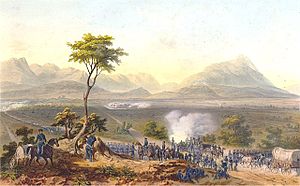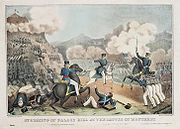| Battle of Monterrey | |||||||
|---|---|---|---|---|---|---|---|
| Part of Mexican-American War | |||||||
 US troops marching on Monterrey during the Mexican-American War, painting by Carl Nebel. | |||||||
| |||||||
| Belligerents | |||||||
|
|
| ||||||
| Commanders and leaders | |||||||
| Zachary Taylor |
Pedro de Ampudia Jose Garcia-Conde Francisco Mejia | ||||||
| Strength | |||||||
| 6,220 |
4,000 Regulars;2,000 Cavalry; 250 artillery 3,000 Militia and about 46 guns & howitzers( 28 field) | ||||||
| Casualties and losses | |||||||
|
531 (120 Killed 368 Wounded 43 missing) | 367 Killed and Wounded and about 40 guns & howitzers | ||||||
| |||||
In the Battle of Monterrey (September 21–24, 1846) during the Mexican-American War, General Pedro de Ampudia and the Mexican Army of the North was defeated by the Army of Occupation, a force of United States Regulars, Volunteers and Texas Rangers under the command of General Zachary Taylor.
Background[]

Gen. Worth's division marches on Monterrey from the west.
After several defeats and near misses, the Mexican Army of the North, about 2,638 men (1st, 4th and 10th Line, two companies of the 6th and 2d Light Regiments, Mexico and Morelia Activos, 7th, 8th and Light Cavalry Regiments, and 13 pieces of artillery) attempted to retreat south and refit before engaging United States forces under General Zachary Taylor. Near the old fortress town of Monterrey, General Pedro de Ampudia received orders from Antonio López de Santa Anna to retreat further to the city of Saltillo, where Ampudia was to establish a defensive line. But Ampudia, who was hungry for victory and conscious that his men were nearing mutiny through constantly being forced to retreat, refused the order and chose instead to make a stand at Monterrey.
Joining Ampudia at this engagement were reinforcements from Mexico City totaling 3,140 men: 1,080 men of the Garcia-Conde Brigade (Gen. Jose Garcia Conde) (Aguascalientes and Querétaro Battalions, two squadrons 3d Line Cavalry, three guns (3-8 lb)), a thousand men of the Azpeitia Brigade ( Col. Florencio Azpeitia) (3d Line, two squadrons Jalisco lancers, two squadrons Guanajuato Cavalry Regiment, six guns (8 & 12 lbs.) and an Ambulance), 1,060 men of the Simeon Ramirez Brigade (Acting Gen Ramirez) (3d and 4th Light, three guns (1-8 lbs, 2-12 lbs) & 3 howitzers 7" (Capt P.Gutierrez & Comdte A. Nieto)) and an artillery unit, the largely Irish-American volunteers for Mexico called San Patricios (or the Saint Patrick's Battalion), in their first major engagement against U.S. forces.

American depiction of the fighting within the city.

Map of the town's defences that appeared in Personal Memoirs of Ulysses S. Grant

Storming of Palace Hill at the Battle of Monterey by Tompkins Harrison Matteson, c. 1855
Battle[]
The Mexican strong points were at the Black Fort, the Tannery (la Teneria), El Rincon del Diablo, Purisima tetes-de-pont (two bridges), Ft. Libertad, the Bishops' Palace (Obispado) and Federacion Redan. Units were shifted about, but were generally as follows: -1.) the Black Fort : Col. Tyrore Uraga and 9 guns, -2.) the Tannery : 2d Ligero (Col. Jose M. Carrasco) and Queretro (Comdte. Jose M. Herrera) Battalions and 3 guns (1-8 lb,1-4 lb & 1 mtn.howitzer) (Lt Juan Expejo), -3.) El Rincon: Lt. Col. Calisto Bravo and 3 guns (Capt. Ignacio J. del Arenal) -4.) Purisima : Aguascalientes Battalion (Col. Jose Ferro)and one gun(1-12 lb)(Capt Patricio Gutierrez) -5.) Ft. Libertad and 4 guns, -6.) Obispado: various units (Lt. Col.Franciso Berra of Mexico Activos Bn)) and 4 guns, -7.) Federacion Redan and 2 guns, and -8.) the Reserves at la Plaza :3d Ligero (Lt.Col.Juan Castro) and 1 gun (1-8 lb) (Lt Agustin Espinosa). General Zachary Taylor, commander of all U.S. forces, decided to attack western Monterrey in a giant "hook" movement while carrying out a small diversion against northeastern Monterrey. On September the 21st, William Jenkins Worth overran Federation Hill in western Monterrey, there was a light skirmish with the Mexican cavalry and the Jalisco (Col. Juan Najera) and Guanajuato (Lt. Col. Mariano Moret)lancers being replused with the commander of the former killed.In the mean time Taylor launched a diversion against eastern Monterrey. This diversion quickly grew into a full-out assault as Taylor threw half of his overall army against northeast Monterrey. In order to reach El Fortin de la Teneria the 1st Division under command of Brigadier General Worth had to pass through the areas of cannon fire from at least 4 other forts as they moved forward toward El Fortin Del teneria. Taylor's best infantry division was repelled by 200 Mexican soldiers in El Fortin Del Teneria (Tannery Fort) until the end of the day when his men finally managed to overrun the fort. Jefferson Davis's Mississippians and a Tennessee regiment under Colonel William Campbell stormed over its wall with bayonets and swords.[1][2]
On September 22, 1846, General Worth attacked a second more fortified hill called Independence Hill where an old Bishop's palace (Obispado)was located that contained 300 Mexican soldiers. Worth's men climbed the steep slopes of the hill, attacked a small redoubt, and tricked the Mexican soldiers inside the Bishop's Palace to advance out of the fort into the middle of hill, where they were attacked from both sides by Texan volunteers and from the middle by Louisiana volunteers and regular soldiers.[1]

Image of 1847. Title Monterrey from Independence Hill, in the rear of the bishop´s palace. On stone by F. Swington. Colored by G. & W. Edicott, New York. The image depicts the Settle Hill and the bishop´s house in Monterrey Mexico after the Battle of Monterrey in 1846.
On September 23, General Worth advanced into the city from the west while Taylor moved his men into the city from the east. The Texan volunteers taught the U.S. regulars new techniques for fighting in the city; techniques that they did not employ on the 21st which led to staggering casualties. Armed with these new urban warfare skills, the U.S. Army along with Texan, Mississippian, and Tennessee volunteers moved house to house, rooting out Mexican soldiers hiding on rooftops and inside the thick, adobe-walled houses of northern Mexico.[3][4]
The Mexican Army and the city's remaining citizens congregated in the city plaza. Trapped in the city plaza and bombarded by U.S. forces with howitzers, General Ampudia decided to negotiate. Taylor, still facing a larger army in enemy territory, negotiated a two month armistice in return for the surrender of the city. The Mexican Army was allowed to march from the city on the 26th, 27th and 28th of the month, with their arms and one battery of artillery (six guns). Left behind were some 25 guns. Although it was considered another victory for the United States, the number of American and Mexican casualties were high. The Americans lost 120 with over 368 wounded/injured,the Mexican side lost 123 with over 325 wounded/injured. Both totals far more then in the 2 previous confrontations.
Aftermath[]
The resulting armistice signed between Taylor and Ampudia had major effects upon the outcome of the war. Taylor was lambasted by some in the federal government, where President James K. Polk insisted that the U.S. Army had no authority to negotiate truces, only to "kill the enemy". In addition, his terms of armistice, which allowed Ampudia's forces to retreat with battle honors and all of their weapons, were seen as foolish and short-sighted by some U.S. observers. For his part, some have argued that Ampudia had begun the defeat of Mexico. Many Mexican soldiers became disenchanted with the war. In a well-fortified, well-supplied position, an army of ten thousand Mexican soldiers had resisted the U.S. Army for three days, only to be forced into surrender by American urban battle tactics, heavy artillery and possibly further division in the Mexican ranks.
See also[]
References[]
- ↑ 1.0 1.1 Chris Dishman, "Street Fight in Monterrey," Military Heritage Magazine, August 2009.
- ↑ Valtier, Ahmed. “Fatídica Orden: Asalto Yanqui Sobre Monterrey.” Atisbo, Year 1, vol. 4 (September 2006).
- ↑ Chris Dishman, "Street Fight in Monterrey," Military Heritage Magazine, August 2009\.
- ↑ Urban Warfare at Monterrey - Battleofmonterrey.com
- Toro, Alfonso "Historia de México", vol. 2, pp. 372–374.
- Bauer, K. Jack. "The Mexican War, 1846-1848"
- Alcaraz, Ramon et al. "Apuntes Para la Historia de la Guerra Entre Mexico y los Estados Unidos"
- Balbotin, Manuel "La Invasion Americana, 1846 a 1848"
- Grant, U.S. "Personal Memoirs of U.S. Grant, Vol I, pp 74-82", ISBN 0-940450-58-5
- Note 1 Alcaraz in "Apuntes..." lists the initial Mex. units on pp 90–91.
- Note 2 Balbontin in " La Invasion" lists the Mex. reinforcements on pp 10–11. He lists units and artillery at some of the defense points.
- Annual Reports 1894, War Department list trophy guns as: 1- 12 pounder, 3- 8 pounders, 2- 4 pounders, 2- 4 pounder mountain howitzers & 1- 68 pound howitzer.
Further reading[]
- Eisenhower, John S. D. (1989). So Far from God, The U.S. War with Mexico, 1846-1848. Random House. ISBN 978-0-8061-3279-2.
- Dishman, Christopher, ''A Perfect Gibraltar: The Battle for Monterrey, Mexico," University of Oklahoma Press, 2010 ISBN 0-8061-4140-9
- Gateway South: The Campaign for Monterrey. U.S. Army Center of Military History.
External links[]
- The Capture of Monterrey - PBS U.S.-Mexican War
- The Battle of Monterrey - A Continent Divided: The U.S.-Mexico War, Center for Greater Southwestern Studies, University of Texas at Arlington
- Nuevo Leon, Historic Sites of the U.S.-Mexican War - Descendants of Mexican War Veterans
- Battle for Monterrey, Mexico
The original article can be found at Battle of Monterrey and the edit history here.